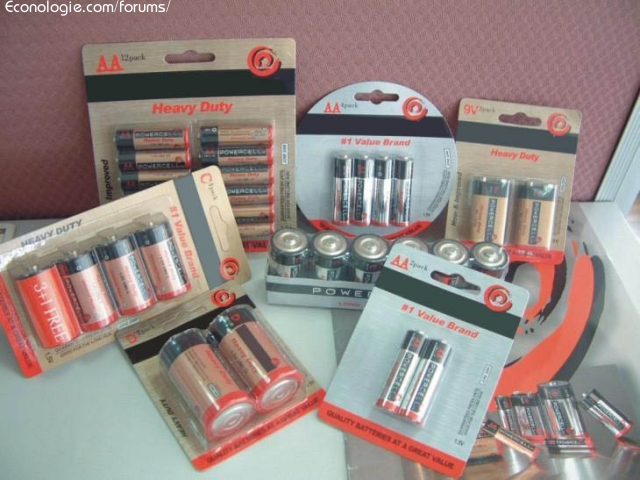Changing a battery charger
published: 30/09/09, 15:24
Because "standard" NiMH batteries (AAA, AA, "baby C", "mono D" etc.) offer ever higher current intensities, a good number of chargers are becoming obsolete. Because they no longer charge the batteries optimally it seems.

I then went to the Econologie shop to buy a new one and cheap for top top at 44.50EUR
.... but what about my old charger? Throw it in the trash? What neni!
Lost for lost, I embarked on the transformation of the latter, a Ansmann Accufresh5
The transformation time has cost me more than new charger ... but it is to avoid waste. And then take my car where I am would qmm caught 1 / 2 day round trip ...
And then take my car where I am would qmm caught 1 / 2 day round trip ...
It has a button to discharge the batteries before recharging and automatically stops charging (still happy ...) after a period of approx. 16h00 for NiMH (8h00 for NiCd).
Before transformation, he proposed the following intensities:
- micro AAA: NiCd 280-350 // NiMH 500-700 mAh.
- mingon AA: NiCd 700-900 // NiMH 1400-1800 mAh
- baby C: NiCd 2000-2500 mAh // NiMH 3500-4000 mAh.
- the mono D: NiCd 4000-4500 mAh // NiMH 7000-8000 mAh.
I then got the idea to bridge the AAA on the AA, then the AA on the "baby C" to take advantage of greater intensity.
Result
- With micro AAA I am able to charge up to 1400-1800 mAh.
(before NiCd 280-350 // NiMH 500-700 mAh)
- with the mingon AA I am able to charge batteries up to 3500-4000 mAh.
(before NiCd 700-900 // NiMH 1400-1800 mAh)
- the baby C => unchanged: NiCd 2000-2500 mAh // NiMH 3500-4000 mAh.
- mono D => unchanged: NiCd 4000-4500 mAh // NiMH 7000-8000 mAh.
Everything seemed to work perfectly ... Except that now the charge of NiMH batteries "mignon AA" seems to disturb the logic of the charger (since having inherited the charge ratios of the "Baby C" apparently better in accordance with my news 2500 mAh).
Indeed it takes a considerable time to empty them and tends to go below the usual 1 Volt and de facto it does not seem to want to switch to "charge" at the appropriate time (as it continues to descend below, I dare not try for fear of damaging the batteries).
An explanation?

I then went to the Econologie shop to buy a new one and cheap for top top at 44.50EUR
.... but what about my old charger? Throw it in the trash? What neni!
Lost for lost, I embarked on the transformation of the latter, a Ansmann Accufresh5
The transformation time has cost me more than new charger ... but it is to avoid waste.
It has a button to discharge the batteries before recharging and automatically stops charging (still happy ...) after a period of approx. 16h00 for NiMH (8h00 for NiCd).
Before transformation, he proposed the following intensities:
- micro AAA: NiCd 280-350 // NiMH 500-700 mAh.
- mingon AA: NiCd 700-900 // NiMH 1400-1800 mAh
- baby C: NiCd 2000-2500 mAh // NiMH 3500-4000 mAh.
- the mono D: NiCd 4000-4500 mAh // NiMH 7000-8000 mAh.
I then got the idea to bridge the AAA on the AA, then the AA on the "baby C" to take advantage of greater intensity.
Result
- With micro AAA I am able to charge up to 1400-1800 mAh.
(before NiCd 280-350 // NiMH 500-700 mAh)
- with the mingon AA I am able to charge batteries up to 3500-4000 mAh.
(before NiCd 700-900 // NiMH 1400-1800 mAh)
- the baby C => unchanged: NiCd 2000-2500 mAh // NiMH 3500-4000 mAh.
- mono D => unchanged: NiCd 4000-4500 mAh // NiMH 7000-8000 mAh.
Everything seemed to work perfectly ... Except that now the charge of NiMH batteries "mignon AA" seems to disturb the logic of the charger (since having inherited the charge ratios of the "Baby C" apparently better in accordance with my news 2500 mAh).
Indeed it takes a considerable time to empty them and tends to go below the usual 1 Volt and de facto it does not seem to want to switch to "charge" at the appropriate time (as it continues to descend below, I dare not try for fear of damaging the batteries).
An explanation?